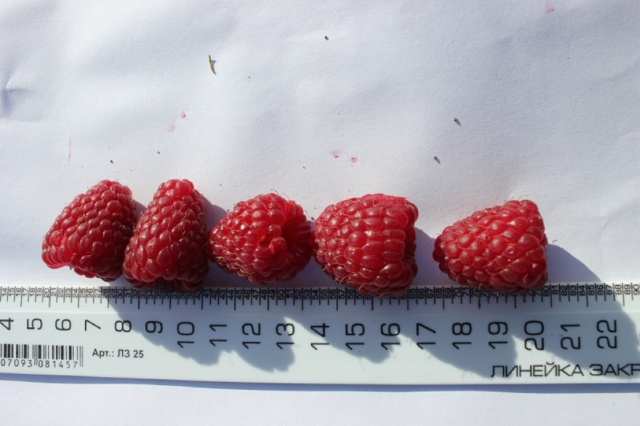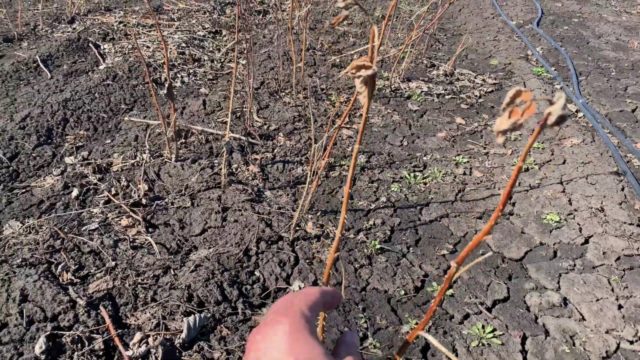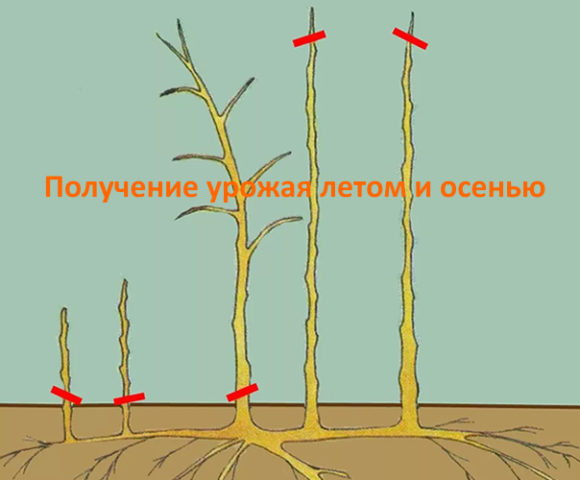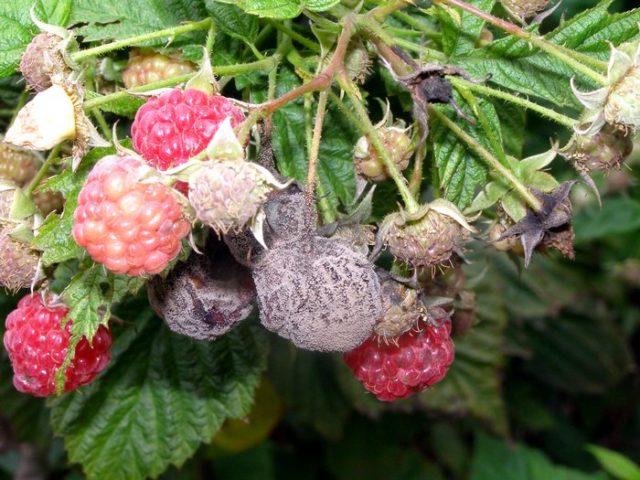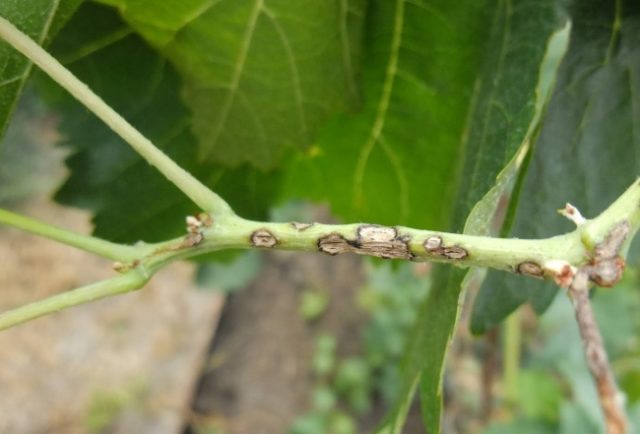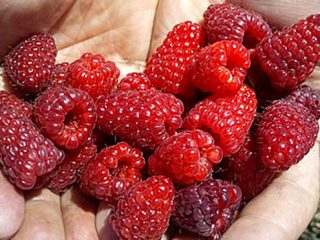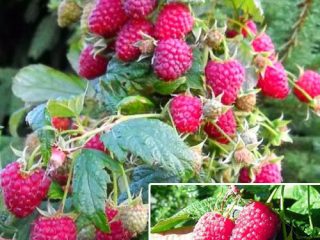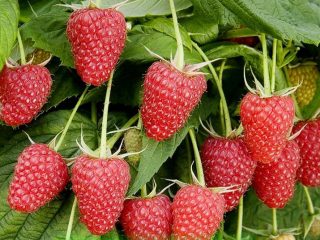Content
- 1 Description of the raspberry variety the Little Humpbacked Horse
- 2 Pros and cons of raspberry the Little Humpbacked Horse
- 3 Planting and caring for raspberries the Little Humpbacked Horse
- 4 Harvesting
- 5 Reproduction
- 6 Diseases and pests
- 7 Conclusion
- 8 Reviews of raspberries of the Konek-Humpbacked variety
Among the varieties of raspberries that ripen in the first place, a new favorite in terms of yield and taste has recently appeared - the Little Humpbacked Raspberry. For this period of time, the variety is only undergoing a state test. The seedlings will go on sale in 2020, however, an active discussion of this variety is already underway on the forums of gardeners and truck farmers.
Description of the raspberry variety the Little Humpbacked Horse
The Little Humpbacked Horse belongs to the remontant raspberry culture. This means that the fruiting period lasts until late autumn. A bountiful harvest can be harvested at least twice a year. The variety is characterized by the earliest ripening of fruits: the berries appear already in mid-July. They have an oval shape, very sweet taste and large size (the weight of one berry reaches 12 g).
The fruit of the Humpbacked Horse raspberry variety has a rich scarlet color and shine. On the bush, they ripen in clusters: several large berries hang on one brush at once. In addition, they keep very well and can be used for long-term transportation.
The plant itself looks very compact. Shrubs are not very tall (they stretch up to 1 m). Leaves are slightly pubescent, dark green in color. Thorns are predominantly located in the lower part of the shoots. The upper and middle parts are not strongly studded. The variety has a high shoot substitution, which allows you to quickly breed raspberries in the garden.
An overview of the variety can be viewed at the link: https://www.youtube.com/watch?v=s4-6EtYeLb0.
Pros and cons of raspberry the Little Humpbacked Horse
The Little Humpbacked Horse is perfect both for growing raspberries "for yourself" and for production scales. The variety has a number of advantages:
- large and very tasty fruits that ripen faster than other representatives of this culture;
- every year the level of raspberry yield increases;
- berries easily tolerate long-term transportation;
- raspberries multiply easily and quickly, so you don't have to spend money on a large number of seedlings;
- The Little Humpbacked Horse begins to bear fruit in the first year after disembarkation;
- the variety is relatively resistant to light frosts;
- the variety is quite unpretentious in terms of care;
As you can see, raspberries have a sufficient number of positive aspects. But, despite their large number, the shrub also has a number of negative sides:
- The humpbacked horse lets out a lot of shoots, which in a short period of time can clog the entire area. It is required to constantly monitor the shrub and the degree of its growth.
- It is necessary to monitor the pH level of the soil environment: if it is acidic, then raspberries will not give a large harvest.
Planting and caring for raspberries the Little Humpbacked Horse
Although the variety is considered quite unpretentious in terms of planting and care, the elementary rules of the agrotechnical industry should not be neglected. Thanks to this approach, the yield of raspberries will be at a high level.
Selection and preparation of the landing site
The raspberry area should be well lit.Therefore, an open area without shaded areas is suitable for growing a crop. The Little Humpbacked Horse loves loamy or sandy loam soil, clayey is less preferable. Before planting, the land is cultivated: it is cleaned of weeds, biological fertilizers (humus) are applied, as well as potassium and superphosphate. Such actions contribute to the fact that raspberries quickly take root and develop fully. Immediately before planting, the site is plowed and loosened.
Landing rules
One of the main points to consider when planting is the preparation of seedlings. It is necessary to ensure that their root system is well developed, and the cut off part of the stem does not exceed 30 cm.
The best time to plant raspberries is autumn (late September, early October). If you plant the Humpbacked Horse variety during this period, then it will have enough time to take root and prepare for the cold weather. If it is not possible to plant in early autumn, it is better to postpone it until early spring.
When growing the Little Humpbacked Horse on an industrial scale, the interval between shrubs should be 100 cm, and between rows 350 cm.When planting in a summer cottage, a distance between bushes of 60-100 cm is sufficient, and between rows - 100-150 cm.
The seedling hole should be of such depth and width that the entire root system can be freely placed inside. In this case, the root collar itself does not deepen, it is left above the surface of the earth. After the hole is covered with earth, tamped a little and moistened abundantly. It is also recommended to mulch the soil later.
Watering and feeding
The first time after planting, raspberry bushes are watered abundantly: approximately every 3-5 days. As soon as raspberries adapt to new conditions and take root, they need to be watered only during flowering and fruit formation. The soil must be sufficiently saturated, so at least one bucket of water is required per bush.
Also, additional and abundant moisture is carried out in the fall. This procedure will prepare the Little Humpbacked Horse for the winter period.
Raspberries should be fed in the spring. In this case, it is recommended to use organic matter, for example, bird droppings or mullein. Mineral and nitrogen fertilizers are used only for old bushes. It is recommended to make them at the beginning of summer. In the fall, so that the Little Humpbacked Horse is not depleted, you can feed it with a ready-made mixture. One of the options is Kemir's fertilization.
Pruning
Raspberries can be trimmed in several ways:
- Standard, like all other representatives of culture;
- completely remove all stems in the fall.
First option:
Second option:
If you choose the first option, then in the fall all two-year-olds, as well as young unformed shoots, are cut to the same length. The rest of the branches remain. Such pruning allows you to harvest twice: in summer and autumn.
In the second option, absolutely all shoots are removed in the fall. Raspberries for next year will give a later harvest, but it will not differ in volume.
Preparing for winter
In the period of preparation for winter at the Little Humpbacked Horse, all unnecessary branches and pathogenic vegetation growing around are removed. Also, in order for the shrub to be saturated with nutrients, it can be fertilized in the fall.
If the shoots were preserved when pruning raspberries, then they should be tilted to the ground and covered with non-woven material before the onset of cold weather. The top will need to be additionally insulated with needles or humus. If all stems were removed, then soil in their growth area will need to be mulched.
Harvesting
Raspberry harvesting usually begins in mid-July. This period continues in autumn. On an industrial scale, berries are harvested mechanically. At the summer cottage, all the fruits are harvested by hand.
Reproduction
One of the ways to propagate raspberries is by cuttings.The required material is obtained in the process of pruning the shrub in autumn or spring. In order for the stalk to be ready for planting, it is added to the ground for the winter, wrapped in foil in the spring and periodically moistened.
The second breeding option is shoot replacement. In order to increase the number of raspberry bushes, it is enough just to deliberately damage the roots with a shovel.
Diseases and pests
Raspberry the Little Humpbacked Horse is considered a variety that is quite resistant to diseases. However, under unfavorable conditions or for other reasons, the following diseases can affect it:
- Gray mold fungi... First, the raspberries are affected, then the plaque spreads to the foliage and stems. The growth of diseased bushes is observed during cold and damp weather.Important! The neighborhood with strawberries contributes to the development of gray rot fungi in the Little Humpbacked Horse.
- Purple spot... A dangerous fungal disease that primarily affects weak plants. Shoots are hit first, then the buds, tops of the leaves and the leaf plates themselves. Excess nitrogen in the soil can contribute to the development and occurrence of the disease.
- Raspberry anthracnose... Depressions and damaged areas form on the stem. Further, the disease affects the foliage of the Little Humpbacked Horse variety.
Among the pests, the most common are stem fly and raspberry gall midge, as well as weevil, glass beetle, raspberry beetle and a number of others. It is best to prevent insects from appearing than to deal with them later.
Conclusion
Raspberry the Little Humpbacked Horse will delight every gardener. The variety is just passing the stage of state testing, but already at this stage it has shown itself from the best sides. This means that its popularity among gardeners and gardeners will only increase every year.

